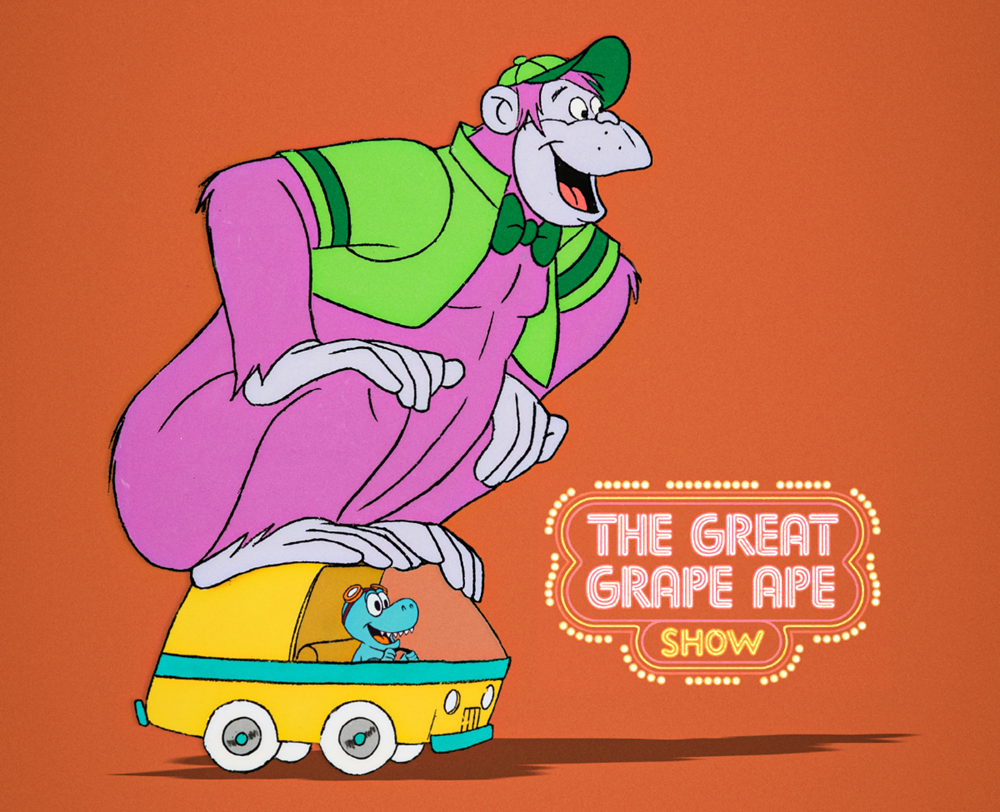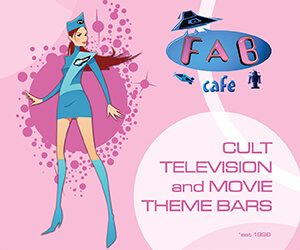Ah, telephemera… those shows whose stay with us was tantalisingly brief, snatched away before their time, and sometimes with good cause. They hit the schedules alongside established shows, hoping for a long run, but it’s not always to be, and for every Street Hawk there’s two Manimals. But here at STARBURST we celebrate their existence and mourn their departure, drilling down into the new season’s entertainment with equal opportunities square eyes… these are The Telephemera Years!
Godzilla x Kong Special
With Godzilla x Kong: The New Empire riding high in the movie charts – and with a gap in the schedule to fill! – this week’s Telephemera Years dips into the archive to look at the Saturday morning shows that featured those loveable giant apes and lizards!
The King Kong Show (ABC, 1966-67): A co-production between American studio Rankin/Bass and the Japanese animators at Toei, The King Kong Show ran for three seasons from 1966 but hasn’t left quite the mark that the later Hanna-Barbera Godzilla cartoon, with or without Godzooky.
With character designs by infamous EC Comics artist Jack Davis, The King Kong Show’s main feature saw the giant ape befriending the Bond family, who were worldwide adventurers, with Kong acting as a protector of humanity. As was often the way, there was a back-up feature entitled Tom of T.H.U.M.B., parodying the spy craze of the time, which saw a secret agent reduced to just three inches tall.

While the show was in development, Rankin/Bass began a partnership with Toho, the Japanese film studio responsible for the Godzilla series, looking to make a sequel to Toho’s 1962 King Kong vs Godzilla (which had originally been intended to be King Kong vs Frankenstein!), in which Kong would fight giant crab Ebirah, but disagreements over who would direct the film saw Rankin/Bass drop out and Kong’s part filled by Godzilla. The studios settled their differences in time to make King Kong Escapes in 1967, which was loosely based on the animated show.
The first eight episodes are available on DVD through Sony, but you’ll have to trawl video sharing sites for the rest, including the debut of Mechani-Kong, the not-at-all MechaGodzilla-inspired robot ape that later turned up in King Kong Escapes.
Godzilla (NBC, 1978-79): You all know the story of Godzilla by now, right? Mankind’s stupidity and eagerness to destroy itself results in an ancient creature being awakened which cuts a swathe of radioactive revenge across a Japan only nine years removed from the atomic bomb atrocities in Hiroshima and Nagasaki, eventually becoming the Earth’s defender against similar creatures from outer space, even though we don’t deserve him?
The big green lizard starred in fifteen Japanese films from the Toho studio between 1954 and 1975 when the series was halted following lacklustre box office receipts for Terror of Mechagodzilla, and most of these films found an American audience in dubbed versions shown in fleapits, drive-ins, and on late night TV. The lull in Japanese action meant the US was ripe for homegrown Godzilla fare and Marvel Comics were first out of the blocks with a comic book in 1977 that eventually ran for twenty-four issues.

Marvel was not the only company preparing fresh Godzilla for the American market, though, and Joseph Barbera of the Hanna-Barbera animation studio thought the character perfect for his own animated show, tasking Duane Poole and Dick Robbins with coming up with a structure that could showcase the might of the creature while keeping the light peril necessary for such a show. Poole and Robbins created the crew of the research ship Calico, led by Captain Carl Majors and scientist Quinn Darien (Darien’s nephew Pete acted as the audience identification figure).
A typical story would find the Calico stumbling into the kind of dangerous situation that only the intervention of Godzilla could solve, his signature tune ringing out as he emerged from the depths to save the day. Thirteen episodes of the show were ordered, partnered with Jana of the Jungle as The Godzilla Power Hour from September 9th 1978, ultimately leading to a second season which featured the horror that was Godzooky. Toho resumed making Godzilla films in 1985 and there have been several big-screen blockbusters starring the fire-breathing behemoth but for a generation of kids, there’s only one song they hear when they think of Godzilla…
Godzilla: The Series (Fox, 1998-99): Although it was officially a sequel to Roland Emmerich’s 1998 movie, Godzilla: The Series also took inspiration from the 1978 Hanna-Barbera cartoon series, presenting a giant monster that was a friend to mankind and – in particular – one young man. Rather than Pete Darien and the crew of the Calico, this Godzilla “imprinted” on intrepid scientist Dr Nick Tatopoulos (voiced by Beverly Hills 90210’s Ian Ziering), following him and his crew around as they sought to mitigate the damage caused by monsters hatching all over the world.
The series was developed by former NBC executive Jeff Kline and Richard Raynis, who won six Emmys for his work on The Simpsons, and the two had previously worked on other film to TV transfers such as Jumanji and Men in Black. Their vision for Godzilla was one more faithful to the original movies than Emmerich’s treatment, which had been derided by fans of the property and has subsequently been banished to non-canonical status.

Their Godzilla always seems to know when Nick is in danger and is willing to fight the monsters on behalf of mankind, having no living relatives of his own species. He tussles with such kaiju as giant squids, mutant worms, robotic insects, and even Quetzalcoatl itself, created either a result of ecological disasters or by the sinister forces of Nick’s old college roommate Cameron Winter and his evil allies, including the alien Leviathans.
The first season of Godzilla: The Series premiered on September 12th 1998 and did well enough that Fox commissioned a second series. However, the show was caught up in the ongoing battle for supremacy between Pokemon and Digimon, often finding itself tossed around the schedules for late-programmed Digimon marathons, and two of its forty episodes went unaired in first run due to this kind of messing around. Still, the show retains a solid fandom, although subsequent anime returns to the world of the big green monster have eclipsed its legacy.
Kong: The Animated Series (Fox, 2000-01): Eyeing the success of Godzilla: The Animated Series, which had been spun out of the Dean Devlin and Roland Emmerich movie into two seasons of action on Fox Kids, the German company BKN International partnered with French animators Ellipse to produce this copycat show, featuring the giant ape from Merian C Cooper’s 1933 novel.
Sold initially to the French M6 network, BKN also managed to convince Fox Kids – which had just cancelled Godzilla – to carry their show, with a twenty-episode first season order. The premise of the show had Kong die from his injuries after falling from the Empire State Building, as in the original film, but a scientist Dr Lorna Jenkins managed to take DNA samples which she later used to recreate a clone of the beast. Many years later, she invites her grandson Jason to visit her on Kong Island but the invitation is unknowingly intercepted by an evil scientist bent on using Kong Island’s secrets for his own nefarious schemes…

As well as engineering a clone of a giant ape, Dr Jenkins has also invented the Cyber Link, a device which allows Kong and Jason to switch bodies, and they use this to not only stop the evil scientist but also fight off the forces of the demon Chiros! Yes, this is a busy show, full of densely plotted intrigue and small amounts of peril, and Ellipse (best known for Doug and Babar) did a good job, even if the animation reeks of its early-2000s origins.
A second season continued Kong’s adventures, allowing Jason to switch minds with other large animals, too, and unlike most series of its kind, there was a definite conclusion, although a 2005 movie which took Kong to Atlantis was produced to cash in on the release of Peter Jackson’s King Kong remake. A 2006 sequel to that film followed but the limited success of the Jackson film meant that Kong returned to his island home once again.
The Great Grape Ape Show (ABC, 1975-76): William Hanna and Joseph Barbera created some of children’s television’s most memorable icons, from Fred Flintstone to Scooby Doo, but they had more than their fair share of great characters that didn’t become part of the popular zeitgeist, like Magilla Gorilla, Speed Buggy, and the giant primate, Grape Ape.
Grape Ape was a forty-foot purple gorilla, with a childlike personality, who travels across America with his canine handler, Beegle Beagle. Despite his massive proportions initially frightening everyone they come across, Grape Ape and Beegle stick around long enough to help out a town in trouble before moving on to the next location in/on their little yellow van.

Although complete conjecture on the part of this writer, it’s not impossible that, rather than be inspired by the upcoming 1976 feature King Kong (and, of course, Grape Ape ultimately does trace his lineage back to the original feature), the long lead-in for an animated show might mean that word of Hanna-Barbera’s new project reached Dino de Laurentiis, inspiring him to remake the 1933 Willis O’Brien spectacular. De Laurentiis claims he was driven by the sight of a King Kong poster in his daughter’s bedroom, while Michael Eisner claims he got the idea while watching the original in December 1974, but they would say that, wouldn’t they?
Initially a part of The Tom & Jerry/Grape Ape Show, the giant gorilla’s fifteen double episodes were later repackaged alongside Mumbly shorts and as its own attraction. The character appeared as part of the Yogi Yahooeys in 1978’s Laff-A-Lympics, and most recently turned up in Scoob’s post-credits scene, where he joins Blue Falcon’s Falcon Force.
Next time on The Telephemera Years: We’re off to 2007 and the outer limits of The Telephemera Years where we find… The Bionic Woman?!?
Check out our other Telephemera articles:
The Telephemera Years: pre-1965 (part 1, 2, 3, 4)
The Telephemera Years: 1966 (part 1, 2, 3, 4)
The Telephemera Years: 1967 (part 1, 2, 3, 4)
The Telephemera Years: 1968 (part 1, 2, 3, 4)
The Telephemera Years: 1969 (part 1, 2, 3, 4)
The Telephemera Years: 1970 (part 1, 2, 3, 4)
The Telephemera Years: 1971 (part 1, 2, 3, 4)
The Telephemera Years: 1973 (part 1, 2, 3, 4)
The Telephemera Years: 1974 (part 1, 2, 3, 4, 5)
The Telephemera Years: 1975 (part 1, 2, 3, 4)
The Telphemera Years: 1976 (part 1, 2, 3, 4)
The Telephemera Years: 1977 (part 1, 2, 3, 4)
The Telephemera Years: 1978 (part 1, 2, 3, 4)
The Telephemera Years: 1980 (part 1, 2, 3, 4)
The Telephemera Years: 1981 (part 1, 2, 3, 4)
The Telephemera Years: 1982 (part 1, 2, 3, 4)
The Telephemera Years: 1983 (part 1, 2, 3, 4)
The Telephemera Years: 1984 (part 1, 2, 3, 4)
The Telephemera Years: 1986 (part 1, 2, 3, 4)
The Telephemera Years: 1987 (part 1, 2, 3, 4)
The Telephemera Years: 1989 (part 1, 2, 3, 4)
The Telephemera Years: 1990 (part 1, 2, 3, 4)
The Telephemera Years: 1992 (part 1, 2, 3, 4)
The Telephemera Years: 1995 (part 1, 2, 3, 4)
The Telephemera Years: 1997 (part 1, 2, 3, 4)
The Telephemera Years: 1998 (part 1, 2, 3, 4)
The Telephemera Years: 1999 (part 1, 2, 3, 4)
The Telephemera Years: 2000 (part 1, 2, 3, 4)
The Telephemera Years: 2002 (part 1, 2, 3, 4)
The Telephemera Years: 2003 (part 1, 2, 3, 4)
The Telephemera Years: 2005 (part 1, 2, 3, 4)
The Telephemera Years: 2006 (part 1, 2, 3, 4)
The Telephemera Years: 2008 (part 1, 2, 3, 4)
The Telephemera Years: O Canada! (part 1, 2, 3, 4)
Titans of Telephemera: Irwin Allen
Titans of Telephemera: Stephen J Cannell (part 1, 2, 3, 4)
Titans of Telephemera: DIC (part 1, 2)
Titans of Telephemera: Hanna-Barbera (part 1, 2, 3, 4, 5)
Titans of Telephemera: Kenneth Johnson
Titans of Telephemera: Sid & Marty Krofft
Titans of Telephemera: Glen A Larson (part 1, 2, 3, 4)








